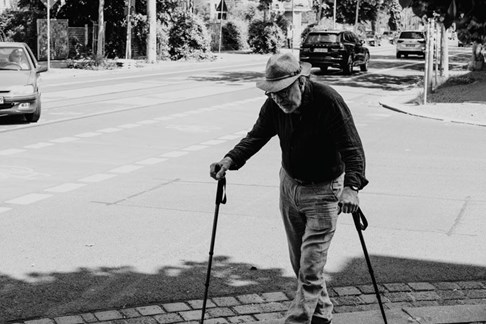
A fall in later life can have a catastrophic impact on a person’s quality of life. Lilian Felipe explains how falls prevention programmes and vestibular rehabilitation can help.
About one third of people over the age of 65 and almost half of people over the age of 80 will fall at least once this year. As time moves forward, so does the population of elderly people in the world. It is predicted that nearly 77 million people in America will make up the population of 65 years and older. The same case can be said for several other countries, including China and the United Kingdom.
Ageing is the primary risk factor for an array of diseases and conditions. One of the most serious problems they can encounter is falling. Falls affect mortality, morbidity, loss of functional capacity and institutionalisation.

The older people get, the more their bodies become easier to injure. This is due to the bones becoming more brittle, skin being easier to puncture, and the brain’s plasticity degenerating [1]. This leads to slower healing times and longer recovery times. As such, elderly individuals have a harder time recovering from injuries they receive, such as concussions or broken bones when they fall [2].
Falling is one of the leading causes in injuries, both minor and fatal, amongst the elderly population. One of the biggest consequences of falling in elderly is the reduction in quality of life. Falling reduces the quality of life by creating limitations in an elderly person’s ability to properly cognitively function, as well as physically function. An elderly person’s quality of life can also be impacted by the medical expense that ensues after a fall has occurred. Over 40 billion dollars is spent on fall-related injuries in the elderly [3].
“Fall prevention has now been integrated into several forms of physical therapy and has shown potential implications for increased health benefits, such as cognitive improvement in task completion”
The pathogenesis of falls is often multifactorial. The risk of falls can be determined by pre-diagnosed health conditions [1]. Risk factors for falls include muscle weakness, a history of falls, use of four or more prescription medications, use of an assistive device, arthritis, depression, age older than 80 years, and impairments in gait, balance, cognition, vision, and activities of daily living. Risks can also be determined by one’s lifestyle and environment [1]. For example, the layout of a room can present potential risk factors. Layout factors can include how furniture is arranged, the amount of walk space, and lighting.
Falls can not only create a physical impact on an individual, but also a cognitive impact. Injuries that occur from falls, such as traumatic brain injuries and concussions, can cause long-term cognitive disorders and conditions [1]. These conditions can include memory loss, lack of focus, dizziness, and headaches.
The goal of fall prevention is to avert potential falls and help minimise the consequences of future ones. Fall prevention is programmes created, through multiple exercises, to decrease the likelihood of an individual’s chance of falling. The exercises in fall prevention programmes include, but are not limited to, standing exercises, squatting exercises, and walking exercises. Exercises with these core abilities are designed to build one’s balance, as well as their ability to be able to complete these tasks without assistance [1,2].
“Vestibular rehabilitation has been shown to be the most effective form of rehabilitation in fall prevention”
Fall prevention has now been integrated into several forms of physical therapy and has shown potential implications for increased health benefits, such as cognitive improvement in task completion. It has been helpful in strengthening muscles, helping maintain balance, and helping individuals become more independent in their daily tasks [2]. It has been proven that fall prevention therapy has helped mitigate risks in future falls, as well as decrease the potential of an individual experiencing falls or repeat falls [2].
Vestibular rehabilitation is used to help rehabilitate individuals that have problems or disorders in balance and maintaining stability. The main systems that help with standing upright are our eyes, legs, and inner ears/vestibular system. When any of these systems are damaged, the ability to maintain standing is no longer achievable and an individual can eventually experience falling. Vestibular rehabilitation has been shown to be the most effective form of rehabilitation in fall prevention [4]. This is due to vestibular rehabilitation improving one’s balance, recovery of balance, functional gait, and posture [4].
“Recent developments in fall prevention have leaned toward virtual reality concepts as well as alert medical devices”
With improvement in all these functions, future falls within the elderly can be prevented, and risks of falls or consequences of repeated falls can be reduced [5]. Recent developments in fall prevention have leaned toward virtual reality concepts as well as alert medical devices [5]. These new technology advents help to lower the costs in fall treatment and therapy. Further developments will continuously progress as technology advances and fall prevention programmes advance along with it.
References
1. Thomas E, Battaglia G, Patti A, ET AL. Physical activity programs for balance and fall prevention in elderly: A systematic review. Medicine 2019;98(27):e16218.
2. Ungar A, Rafanelli M, Iacomelli I. Fall prevention in the elderly. Clin Cases Miner Bone Metab 2013;10(2):91-5.
3. Soto-Varela, A, Gayoso-Diz P, Faraldo-García A, et al. Optimising costs in reducing rate of falls in older people with the improvement of balance by means of Vestibular Rehabilitation (ReFOVeRe study): A randomized controlled trial comparing computerised dynamic posturography vs mobile vibrotactile posturography system. BMC Geriatrics 2019;19(1).
4. Macias JD, Massingale S, Gerkin RD. Efficacy of vestibular rehabilitation therapy in reducing falls. Otolaryngol Head Neck Surg 2005;133(3):323-5.
5. Kundakci B, Sultana A, Taylor AJ, Alshehri MA. The effectiveness of exercise based vestibular rehabilitation in adult patients with chronic dizziness: A systematic review. F1000Research 2018;7:276.









